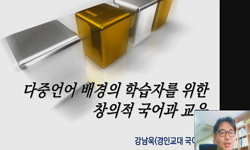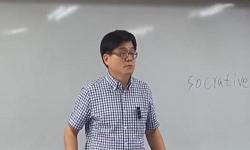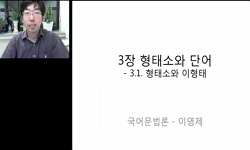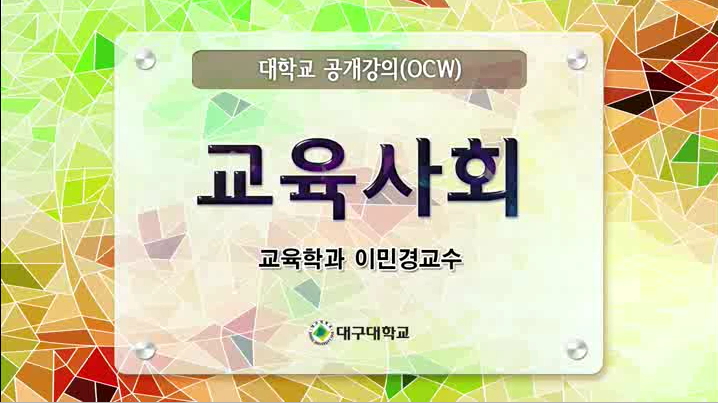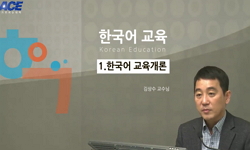The author recently introduced and attempted making a general survey of Korean linguistics documents donated by Nakamura Shojiro (中村庄次郞), who used to be a Korean interpreter from Tsusima Izuhara among books in Ogura Bungo, a literature depar...
http://chineseinput.net/에서 pinyin(병음)방식으로 중국어를 변환할 수 있습니다.
변환된 중국어를 복사하여 사용하시면 됩니다.
- 中文 을 입력하시려면 zhongwen을 입력하시고 space를누르시면됩니다.
- 北京 을 입력하시려면 beijing을 입력하시고 space를 누르시면 됩니다.
오구라문고(小倉文庫)소장 한국어 학습서의 국어학적 고찰
한글로보기https://www.riss.kr/link?id=G3762572
- 저자
-
발행기관
-
-
발행연도
2011년
-
작성언어
Korean
- 주제어
-
자료형태
한국연구재단(NRF)
-
0
상세조회 -
0
다운로드
부가정보
다국어 초록 (Multilingual Abstract)
The author recently introduced and attempted making a general survey of Korean linguistics documents donated by Nakamura Shojiro (中村庄次郞), who used to be a Korean interpreter from Tsusima Izuhara among books in Ogura Bungo, a literature department library in Tokyo University in Japan. Most of the books he donated were the ones he transcribed, and the period of transcription was generally from the end of 1870s to the beginning of 1880s, especially concentrated in 1876. Since the professor Hukui Rei in Tokyo University filled out a list of the documents for the first time in 2005, there has been no full-scale research on each document. Recently, the author obtained a list of complimentary copy of Nakamura Shojiro from the professor Hukui that Ogura Shimpei had. Ogura Shimpei made a separate list of complimentary copies given by Nakamura Shojiro and kept it, and the list was recently discovered. The researcher compared theses documents with the copies, and the researcher intensively studied Geum-Go-Gi-Gwan(今古奇觀), one of these documents, considering the Korean research from the end of 18th century to 19th century was very worthy. First, the researcher studied a historical background for research, and it was found out that since Joseon and Japan started a new friendly relations since 1607 after Japanese Invasion of Korea in 1592, Tsusima played a role as an only official window between Joseon and Japan. Moreover, learning Joseon language in modern Japan mostly happened in Tsusima. Japan, in a neighboring relation with Joseon, realized a necessity of Korean from 18th century and supported Korean education. The person who led it was Amenomori Hoshu, and he founded an official Korean educational institute called Han-eo-sa for the first time at Tsusima. Han-eo-sa trained interpreters who were usually in charge of interpretation at Tsusima, and the training of Joseon language interpreter at Tsusima through this institute was later acceded to the beginning of Meiji era. Nakamura, who donated Korean education textbooks of Ogura Bungo, first visited Pusan in 1868 at the age of 14, and officially started learning Korean at Eo-hak-so once Japan installed it at Pusan in 1873. Later he stayed in Korea and participated in various events such as a diplomatic negotiation between Korea and Japan and retired in 1910. Accordingly, Korean textbooks that he kept are nothing but a model of Korean textbook that came down from the tradition of Amenomori Hoshu. Geum-Go-Gi-Gwan of Ogura Bungo of which book number was [L174704] does not include the original of Chinese literature by written colloquial Chinese, and it is a manuscript of total 48 pieces consisted of only note in the Korean annotation of Chinese classics. This document is the one transcribed from Choryang official residence at Pusan in 1876, and it is supposed to be the one that Nakamura Shojiro transcribed when he was in charge of interpretation of Choryang language center. Geum-Go-Gi-Gwan is a book of tales which was compiled by Po-ong-no-in during Ming dynasty in China, and the period of compilation is estimated to be around 1637. Geum-Go-Gi-Gwan of Ogura Bungo is a note in the Korean annotation of Chinese classics and it includes 3 pieces or work. They are ① Yang-hyeon-ryeong-seong-hon-sa(1-52page) ② Pal-eun-in(53-62page) ③Dong-jeong-hong(63-96page). A written colloquial Chinese Geum-Go-Gi-Gwan which originally included 40 stories were passed onto Korea, a and the translation has not been done perfectly until now. Up to now, ther seem to be no translation of entire Geum-Go-Gi-Gwan. There are 7 books of translation at Seoul National University library, which can be considered as the most, but currently one of them is lost. So far, only ①[Yang-hyeon-ryeong-seong-hon-sa] is handed down out of three stories above among many Chinese versions and translation versions that were passed down. This study attempted a linguistic research on this phenomenon.
국문 초록 (Abstract)
최근 필자는 일본 동경대학 문학부 도서관 <오구라문고>에 소장된 책들 가운데 대마도 이즈하라(嚴原)출신의 한국어통사(통역관)였던 나카무라쇼지로(中村庄次郞)(1855 -1932)가 기증한 국...
최근 필자는 일본 동경대학 문학부 도서관 <오구라문고>에 소장된 책들 가운데 대마도 이즈하라(嚴原)출신의 한국어통사(통역관)였던 나카무라쇼지로(中村庄次郞)(1855 -1932)가 기증한 국어학 자료들을 소개하고 그에 대한 개관을 시도한 바 있다. 나카무라쇼지로가 기증한 책들은 대부분 그 자신이 필사한 것으로, 필사 시기는 대개 1870년대 후반에서 1880년대 전반인데, 특히 1876년에 집중되어 있다. 동경대학의 후쿠이 레이(福井玲)교수가 2005년 처음으로 자료의 목록을 작성한 이래, 그 각각의 자료에 대한 본격적인 연구는 없는 상태이다. 최근 필자는 후쿠이 교수로부터 오구라 신페이가 가지고 있었던 나카무라쇼지로 기증본 목록을 입수하였다. 오구라신페이는 나카무라 쇼지로에게서 받은 기증본들을 별도로 목록을 만들어 보관하고 있었는데, 최근에 그 목록이 발견된 것이다. 연구자는 이 자료들과 사본에 대한 원본 대조 작업을 하였으며, 18세기말에서 19세기에 이르는 한국어의 연구에 매우 중요한 가치가 있다고 생각하고, 이 자료들 가운데 하나인 <금고기관>에 대하여 집중적으로 연구하였다.
우선 연구를 위한 역사적 배경을 고찰하였는데, 임진왜란 후 1607년부터 조선과 일본이 새롭게 통교를 시작한 이래, 대마도는 조선과 일본을 소통하는 유일한 공식 창구로서의 역할을 하였다. 뿐만 아니라 근대 일본에서의 조선어 학습은 대마도에서 주로 이루어졌다. 우리나라와 교린관계에 있던 일본은 18세기부터 한국어의 필요성을 실감하고 본격적으로 한국어 교육을 정책적으로 지원하게 되는데, 이를 주도한 사람이 바로 아메노모리호슈(雨森芳洲: 1668-1755)이며, 처음으로 대마도에 <한어사>라고 하는 공식적인 한국어 교육기관을 세운다. 이 <한어사>은 주로 대마도에서 통역을 담당하던 통사를 양성하였으며, 이곳을 통한 대마번에서의 조선어 통사 양성은 그 후 메이지시대 초까지 계승되었다. 오구라문고의 한국어교재들을 기증한 나카무라는 1868년 14살 때 처음 부산에 다녀갔고, 이어서 1873년 일본이 부산에 <어학소>를 설치하자 거기서 한국어를 공식적으로 배우기 시작했으며, 그후 계속 한국에 머무르면서 한일간의 외교 협상에 임하는 등 활발한 활동을 하다가 1910년에 퇴직했다. 따라서 그가 지니고 있었던 한국어 교재들은 아메노모리호슈의 전통으로부터 내려져 오는 한국어 교재의 전형이 될 수밖에 없다.
도서번호가 <L174704>로 붙여진 오구라문고 금고기관은 백화문으로 된 한문 원문이 들어 있지 않고 단지 언해문만으로 이루어진 총 48 장의 필사본이다. 이 자료는 나카무라쇼지로가 1876년에 부산의 초량공관에서 필사한 것인데, 나카무라쇼지로가 초량어학소의 통역 담당으로 있을 때 필사한 것으로 추측된다.
<금고기관>은 중국 명대 포옹노인(抱甕老人)에 의하여 편찬되었다고 하는 野話인데, 편찬연대는 1637년 전후로 추정된다. <금고기관>에 수록된 40여 편의 고사는 주로 명대 이전에 유전되던 것들을 白話文으로 표기한 단편소설로 유려한 문장과 풍부한 소재로 인해 그 내용이 모두 일품이며 후세의 소설작풍에 영향을 끼쳤다고 할 수 있다. 실제로 <금고기관>은 개화기 우리나라의 신소설의 소재가 되어서 번안소설로 사용되어 출판되기도 하였다.
오구라문고본 <금고기관>은 언해본으로서, 모두 3 개의 작품이 수록되어 있다. ①양현령성혼사(兩縣令成




